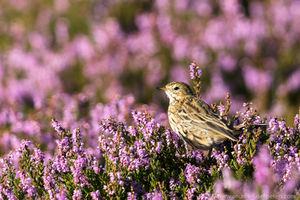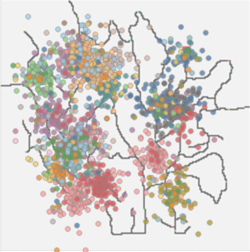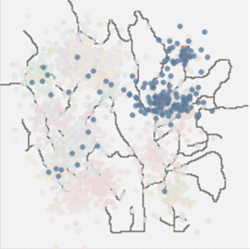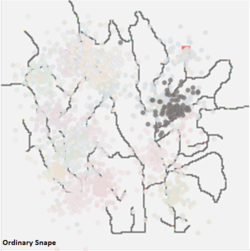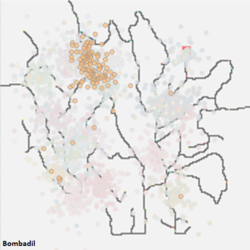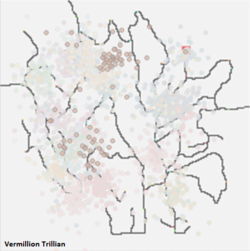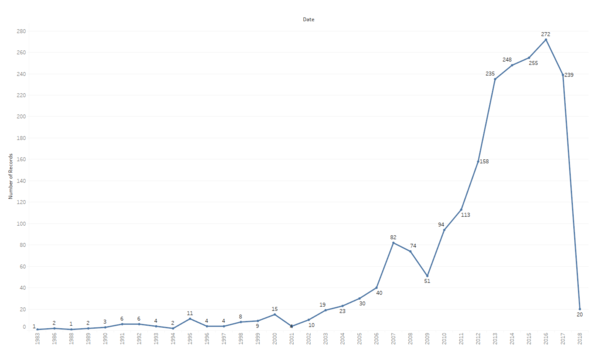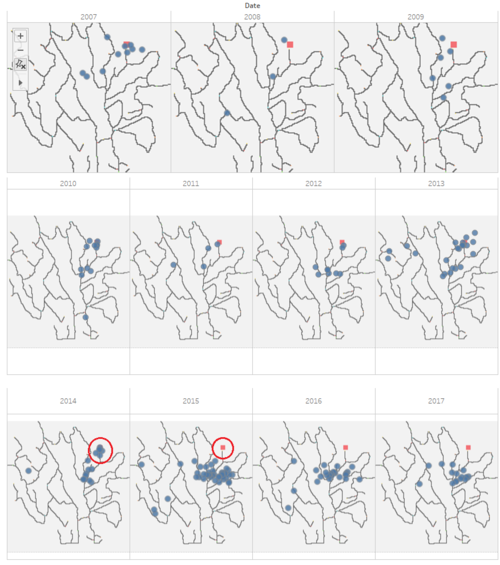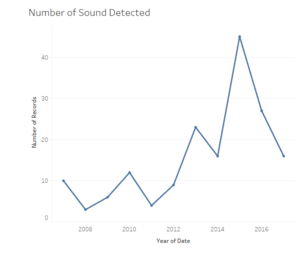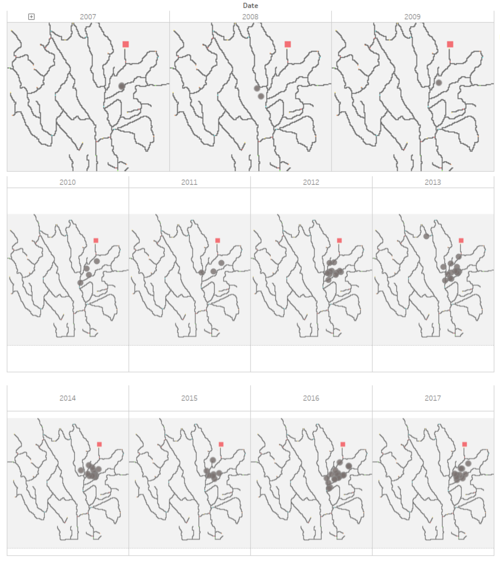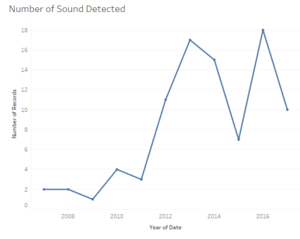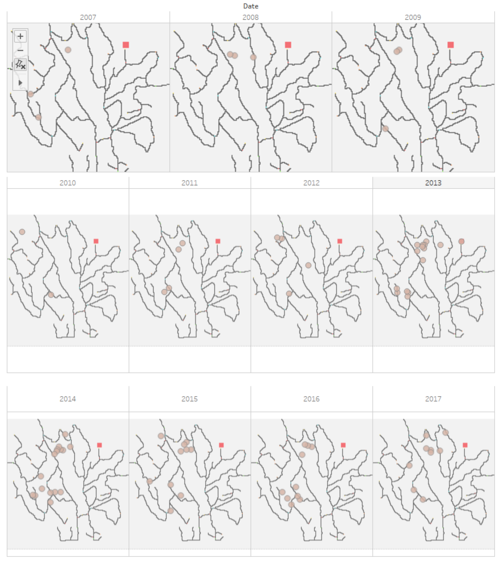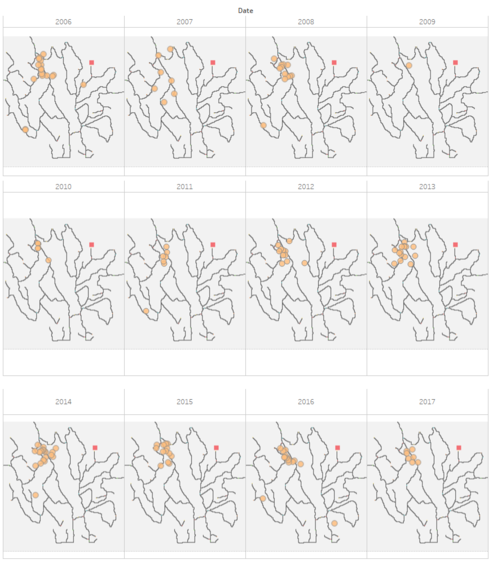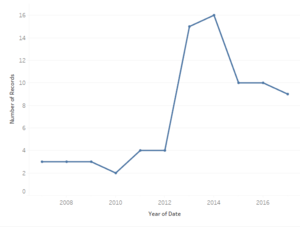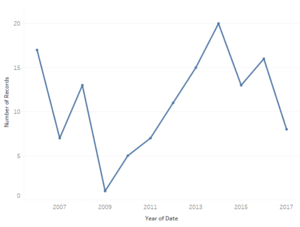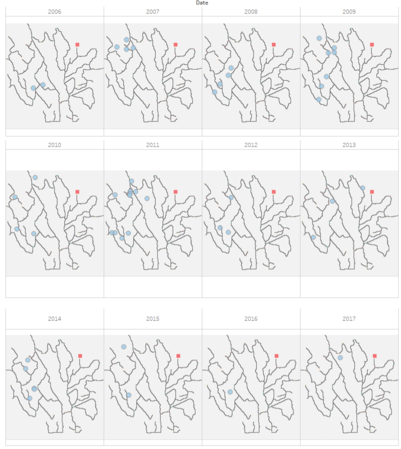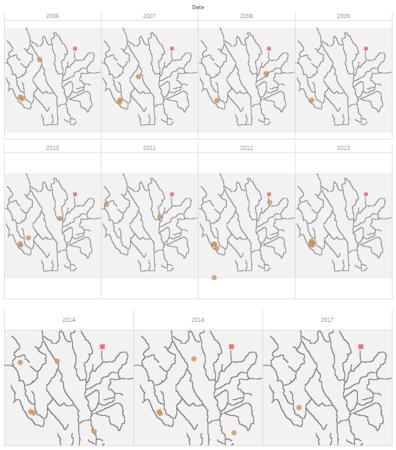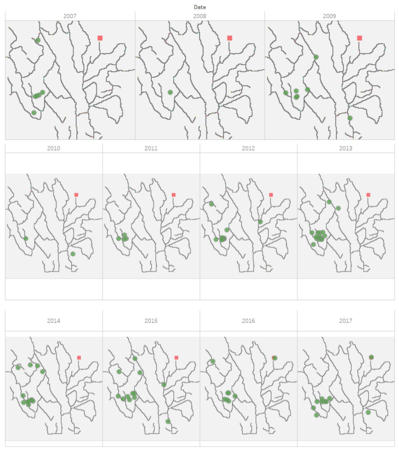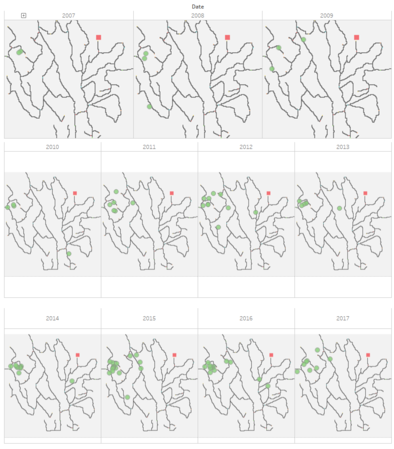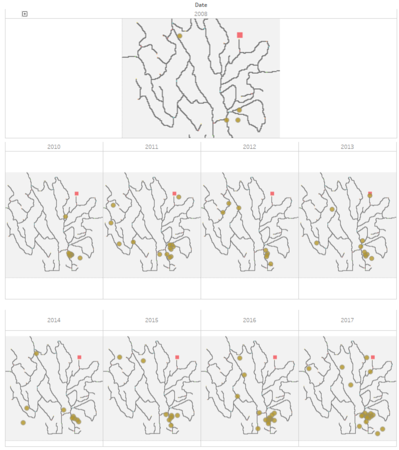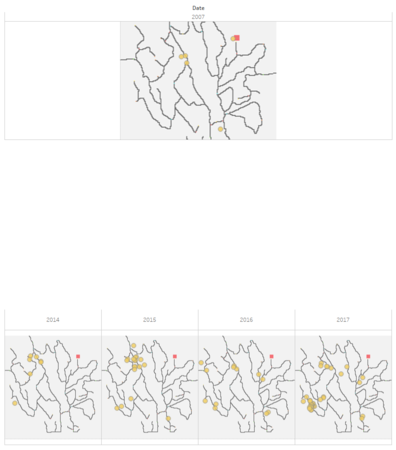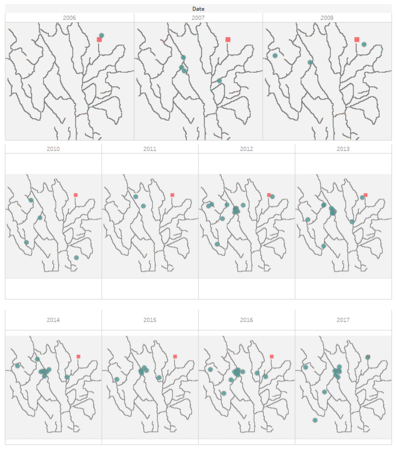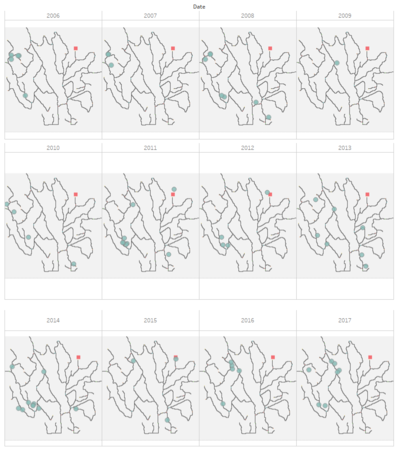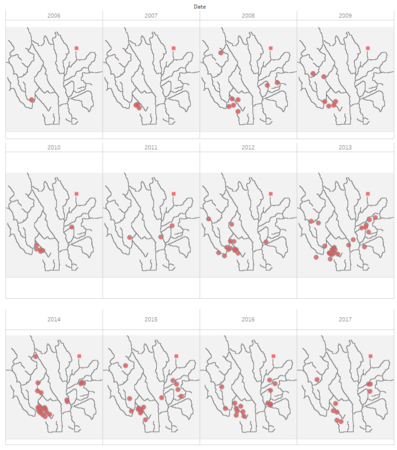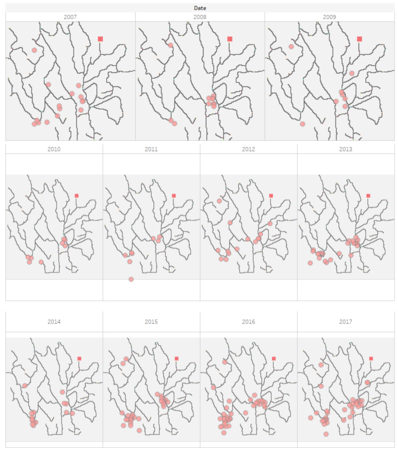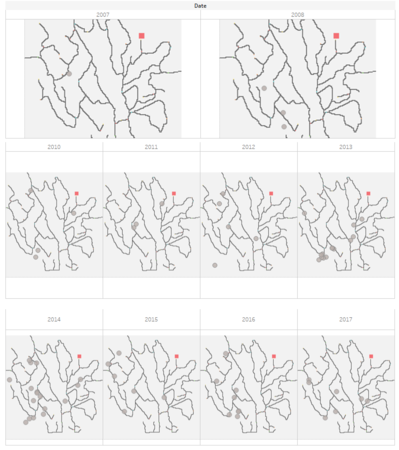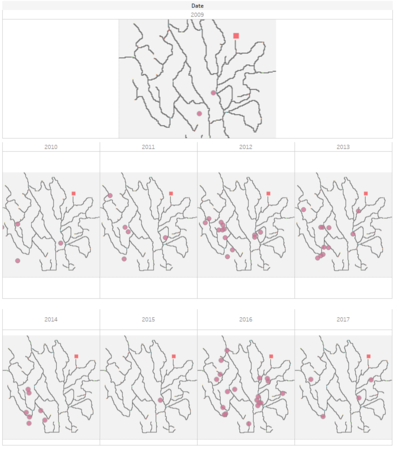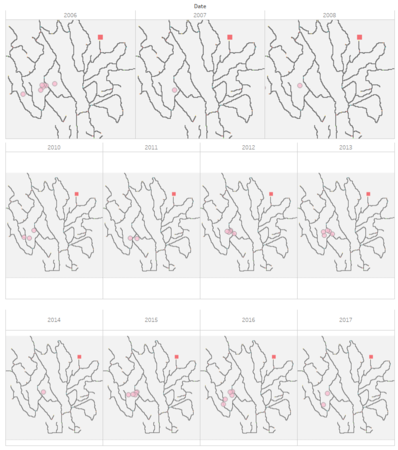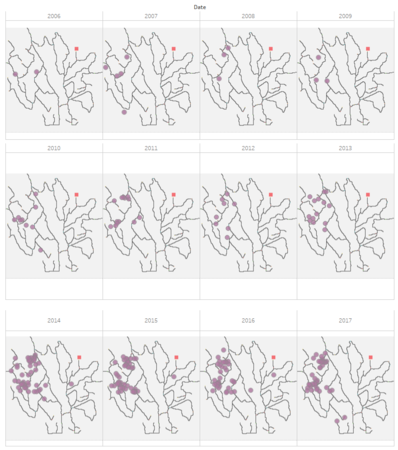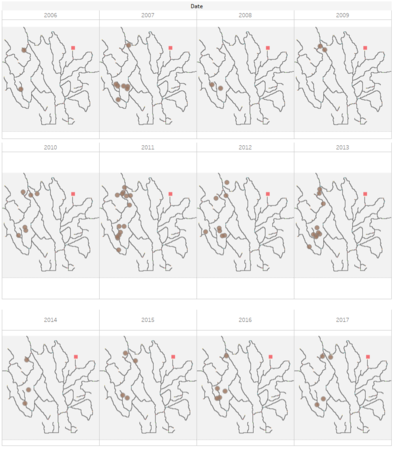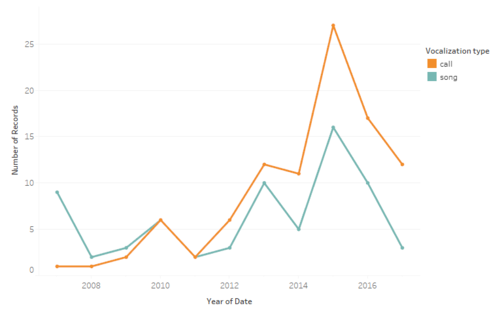Difference between revisions of "ISSS608 2017-18 T3 Assign Anthony Theodore Findings"
(added additional findings) |
|||
| Line 26: | Line 26: | ||
<font size = 3; color="#FFFFFF"><span style="font-family:Century Gothic;"><b>Initial Exploration</b></span></font> | <font size = 3; color="#FFFFFF"><span style="font-family:Century Gothic;"><b>Initial Exploration</b></span></font> | ||
</div> | </div> | ||
| − | Below is the distribution of all bird inside Lekagul Preserve that are detected by sensors. While there are many different | + | Below is the distribution of all bird inside Lekagul Preserve that are detected by sensors. While there are many different bird inside Lekagul Preserve, only Rose-crested Blue Pipit is seen grouping in the alleged dumping site area. Note that there are 2 cluster visible in the map, which are directly above the alleged dumping site, and to the south of said dumping site.<br> |
<div><ul> | <div><ul> | ||
<li style="display: inline-block;"> [[File:Distributionallbird-atheodore.PNG|thumb|none|250px|Distribution of all birds]] </li> | <li style="display: inline-block;"> [[File:Distributionallbird-atheodore.PNG|thumb|none|250px|Distribution of all birds]] </li> | ||
<li style="display: inline-block;"> [[File:Rosepipitonly-atheodore.PNG|thumb|none|250px|Rose-crested Blue Pipit cluster]] </li> | <li style="display: inline-block;"> [[File:Rosepipitonly-atheodore.PNG|thumb|none|250px|Rose-crested Blue Pipit cluster]] </li> | ||
</ul></div> | </ul></div> | ||
| − | Thus looking at this behavior, it made sense that the Kasios was blamed with the disappearance of Rose-crested Blue Pipit. Of all | + | Thus looking at this behavior, it made sense that the Kasios was blamed with the disappearance of Rose-crested Blue Pipit. Of all bird that live inside Lekagul Preserve, Rose-crested Blue Pipit is the bird that will greatly be affected by the dumping situation.<br>However, not only Rose-crested Blue Pipit, but other bird, such as Ordinary Snape is also seen grouping near the dumping site.<br> |
<div><ul> | <div><ul> | ||
<li style="display: inline-block;"> [[File:Ordinarysnape atheodore.PNG|thumb|none|250px|Ordinary Snape cluster]] </li> | <li style="display: inline-block;"> [[File:Ordinarysnape atheodore.PNG|thumb|none|250px|Ordinary Snape cluster]] </li> | ||
| Line 40: | Line 40: | ||
<li style="display: inline-block;"> [[File:Vermillion Trillian atheodore.PNG|thumb|none|250px|Vermillion Trillion cluster]] </li> | <li style="display: inline-block;"> [[File:Vermillion Trillian atheodore.PNG|thumb|none|250px|Vermillion Trillion cluster]] </li> | ||
</ul></div> | </ul></div> | ||
| − | We will use all this | + | We will use all this birds as our control group because if indeed the dumping site was the cause of Rose-crested Blue Pipit disappearance, then these birds should also be affected. As mention in the description, the extent of the area affected by the dumping site is unknown. In our approach, we mention that we only use the data from 2006 - 2017. The reason for this decision was, even though the assignment description stated that ''the patterns are reasonably representative of the bird locations across the area'', all birds did not have significant record until 2006, as seen from the graph. We excluded 2018 because the data recorded for 2018 are until Q1, and has insufficient data for the rest of 2018.<br> |
<div><ul> | <div><ul> | ||
<li style="display: inline-block;"> [[File:Soundrecord atheodore.PNG|thumb|none|600px|Insignificant data below 2006 and insufficient data above 2017]] </li> | <li style="display: inline-block;"> [[File:Soundrecord atheodore.PNG|thumb|none|600px|Insignificant data below 2006 and insufficient data above 2017]] </li> | ||
| Line 48: | Line 48: | ||
</div> | </div> | ||
<h3>1. Disappearance of many birds </h3> | <h3>1. Disappearance of many birds </h3> | ||
| − | Initially, the population of Rose-crested Blue Pipit were increasing. They peaked at 2015, but then gradually decreased until 2017. This may indicate that there is indeed something happened with the Rose-crested Blue Pipit, and by visualizing year by year cluster of the bird, we can see that the bird actually moved away in 2015, as seen below: <br>< | + | Initially, the population of Rose-crested Blue Pipit were increasing. They peaked at 2015, but then gradually decreased until 2017. This may indicate that there is indeed something happened with the Rose-crested Blue Pipit, and by visualizing year by year cluster of the bird, we can see that the bird actually moved away in 2015, as seen below: <br> |
| − | + | <div><ul> | |
| − | < | + | <li style="display: inline-block;"> [[File:Rose pipit map atheodore.PNG|thumb|none|500px|Movement of Rose-crested Blue Pipit. Note the red circleat 2014 and 2015. You can click the image to enlarge the image]] </li> |
| + | [[File:Rosepipit overallsound atheodore.PNG|thumb|right|300px|Number of sound detected for Rose-crested Blue Pipit]] | ||
| + | </ul></div> | ||
The cause of this migration is unknown, but we could assume that it has something to do with the alleged waste dumping taking place, since Rose-crested Blue Pipit is the only bird that cluster in the alleged dumping area, and no other bird display such drastic migration.<br> | The cause of this migration is unknown, but we could assume that it has something to do with the alleged waste dumping taking place, since Rose-crested Blue Pipit is the only bird that cluster in the alleged dumping area, and no other bird display such drastic migration.<br> | ||
| − | For comparison, we will show our control group situation. Ordinary Snape is a | + | For comparison, we will show our control group situation. Ordinary Snape is a bird grouping nearest to the dumping site. If we see at the year by year position, it is very clear that they never migrate outside their cluster, unlike Rose-crested Blue Pipit. However, their population is also decreasing, albeit not as much as Rose-crested Blue Pipit.<br> |
| − | + | <div><ul> | |
| − | The same case also happening with Bombadil and Vermillion Trillian | + | <li style="display: inline-block;"> [[File:Ordinarysnape map atheodore.PNG|thumb|none|500px|Movement of Ordinary Snape. Note that there are no visible migration throughout the year. You can click the image to enlarge the image for better viewing]] </li> |
| − | + | [[File:Ordinarysnape overallsound.PNG|thumb|right|300px|Number of sound detected for Ordinary Snape]] | |
| − | < | + | </ul></div> |
| − | + | ||
| + | The same case also happening with Bombadil and Vermillion Trillian. However, Vermillion Trillian only decreased a little bit, and start to stabilized at 2015 while Bombadil start thriving from 2009 and peaked at 2014, then start to disappear similar to Rose-crested Blue Pipit<br> | ||
| + | <div><ul> | ||
| + | <li style="display: inline-block;"> [[File:Vermillion map atheodore.PNG|thumb|none|500px|Movement of Vermillion Trillian. You can click the image to enlarge the image]] </li> | ||
| + | <li style="display: inline-block;"> [[File:Bombadil map atheodore.PNG|thumb|none|493px|Movement of Bombadil. You can click the image to enlarge the image]] </li> | ||
| + | </ul></div> | ||
| − | <gallery mode="packed-hover" heights=" | + | <div><ul> |
| − | File: | + | <li style="display: inline-block;"> [[File:Vermilliontrillian overallsound atheodore.PNG|thumb|none|300px|Number of sound detected for Vermillion Trillian]] </li> |
| − | File: | + | <li style="display: inline-block;"> [[File:Bombadil overallsound.PNG|thumb|none|300px|Number of sound detected for Bombadil]] </li> |
| − | File: | + | </ul></div> |
| − | File: | + | Below is the gallery image of all other birds (other than control group) position year by year. Notice that some of the year inside that bird is missing. <br>This is due to that in that particular year, there are no bird sound detected for that species. This can mean either the species cluster somewhere where the sensor did not pick up their sound, or there are sudden situation that made the bird disappear entirely in that particular year. Unfortunately, we don't have enough data to analyze.<br> <b>Click on the image to view the map closely.</b> |
| − | File: | + | <gallery mode="packed-hover" heights="300"> |
| − | File: | + | File:Bbr atheodore.PNG|Bent-beak Riffraff |
| − | File: | + | File:Bluecollared zipper atheodore.PNG|Blue-collared Zipper |
| − | File: | + | File:Bwjojo atheodore.PNG|Broad-Winged Jojo |
| − | File: | + | File:Canadiaco atheodore.PNG|Canadian Cootamum |
| + | File:Ccpipit atheodore.PNG|Carries Champagne Pipit | ||
| + | File:Darksparrow atheodore.PNG|Dark Sparrow | ||
| + | File:Easterncs atheodore.PNG|Eastern Corn Skeet | ||
| + | File:Greentippedpipit atheodore.PNG|Green-tipped Scarlet Pipit | ||
| + | File:LB atheodore.PNG|Lesser Birchbeere | ||
| + | File:OPP atheodore.PNG|Orange Pine Plover | ||
| + | File:Pinkfinch atheodore.PNG|Pinkfinch | ||
| + | File:PurpleTT atheodore.PNG|Broad-Winged Purple Tooting Tout | ||
| + | File:Qax atheodore.PNG|Qax | ||
| + | File:Queenscoat atheodore.PNG|Queenscoat | ||
| + | File:Scrawny atheodore.PNG|Scrawny Jay | ||
</gallery> | </gallery> | ||
<br> | <br> | ||
Link for the dashboard: | Link for the dashboard: | ||
<br> | <br> | ||
| − | As we look through the plot of each bird | + | As we look through the plot of each bird, we notice some anomaly detected. Not only Rose-crested Blue Pipit and our control group suffer from the same disappearance, many of other birds away from the dumping site also suffer the same fate. If indeed it was caused by the dumping took place, then birds far away from the dumping site should not be affected by it. This call for concern as there are probably other dire situation that affected the bird population inside Lekagul Preserve. The following is the list of bird that showed decrease throughout the year. |
<br> | <br> | ||
Bird 1 Image 1 | Bird 1 Image 1 | ||
| Line 90: | Line 108: | ||
<h3>2. Change of birds behaviour </h3> | <h3>2. Change of birds behaviour </h3> | ||
| − | + | <div><ul> | |
| − | + | <li style="display: inline-block;"> [[File:Rosepipit callsound atheodore.PNG|thumb|none|500px|Comparison of sound vs call of Rose-crested Blue Pipit]] </li> | |
| + | </ul></div> | ||
By plotting sound and call in one chart, we can see that in 2015, as the population of Rose-crested Blue Pipit started to decrease, the number of call also increased to almost double than the number of song detected. This finding match the earlier finding we acquired, that in 2015 Rose-crested Blue Pipit migrate away from their initial cluster (the dumping site).<br> | By plotting sound and call in one chart, we can see that in 2015, as the population of Rose-crested Blue Pipit started to decrease, the number of call also increased to almost double than the number of song detected. This finding match the earlier finding we acquired, that in 2015 Rose-crested Blue Pipit migrate away from their initial cluster (the dumping site).<br> | ||
The reason why we want to closely look for the vocalization type, referencing on http://www.avianwelfare.org/shelters/pdf/NBD_shelters_minimize_stress.pdf, is that call can seldom be interpreted as sign of distress from birds, and one of the sign that should be look for. Since it is match with our finding earlier, this can indicate that the Rose-crested Blue Pipit population may indeed in stressed condition.<br><br> | The reason why we want to closely look for the vocalization type, referencing on http://www.avianwelfare.org/shelters/pdf/NBD_shelters_minimize_stress.pdf, is that call can seldom be interpreted as sign of distress from birds, and one of the sign that should be look for. Since it is match with our finding earlier, this can indicate that the Rose-crested Blue Pipit population may indeed in stressed condition.<br><br> | ||
| − | As for our control group, Ordinary Snape | + | As for our control group, Ordinary Snape has the same anomaly in behavior as Rose-crested Blue Pipit.<br> |
| − | + | ||
Bombadil and Vermillion Trillian both are not greatly affected by the dumping site, and retain their chirpy behavior throughout the year, although some call still detected. <br> | Bombadil and Vermillion Trillian both are not greatly affected by the dumping site, and retain their chirpy behavior throughout the year, although some call still detected. <br> | ||
image for BM and VT sound call<br> | image for BM and VT sound call<br> | ||
| − | Interesting finding for Vermillion Trillian, even though there are spike on the amount of call detected in 2013-2014, they eventually decrease. This match the finding earlier that the population of Vermillion Trillian | + | Interesting finding for Vermillion Trillian, even though there are spike on the amount of call detected in 2013-2014, they eventually decrease. This match the finding earlier that the population of Vermillion Trillian stabilize in 2015 after decreasing. |
<br> | <br> | ||
<h3>3. Key Observation</h3> | <h3>3. Key Observation</h3> | ||
Some key observation in our finding: | Some key observation in our finding: | ||
| − | + | #Rose-crested Blue Pipit population showing growth from 2007, peaked at 2015, then gradually decreasing until 2017. | |
| + | #Rose-crested Blue Pipit may be the only species that directly affected by the dumping site. This is backed by the map showing they move their cluster away from the dumping site (their initial cluster). | ||
| + | #In 2015, Rose-crested Blue Pipit species singing gradually decreased as their sound turned to call. This is possibly due to stressed condition. | ||
| + | #Our control group, Ordinary Snape and Bombadil, share the same fate as the Rose-crested Blue Pipit, showing sign of struggling albeit did not migrate away. | ||
| + | #*Only Vermillion Trillian species seem adapted to the situation and stabilized. | ||
| + | #A lot of other bird species that cluster far from the dumping site seems to suffer the same fate, showing sign of disappearance throughout the year. This raised multiple possible hypothesis. | ||
| + | ##That the dumping site extent is that much bigger than initially thought. | ||
| + | ##That the dumping site is the not only dire situation inside Lekagul Preserve. There are other dire situation that are not reported that caused the bird to disappear, i.e. died. We can theorize since Rose-crested Blue Pipit is everybody's favorite, other bird species is not detected decreasing as well. | ||
| + | ##That the dumping event does not exist, and the bird disappear simply because of natural event. This is unlikely to be true as there are proof that Rose-crested Blue Pipit did indeed moved away from the alleged dumping site. | ||
<div style="background:#000000; border:#00206; padding-left:15px; text-align:left;"> | <div style="background:#000000; border:#00206; padding-left:15px; text-align:left;"> | ||
Revision as of 02:25, 8 July 2018
|
|
|
|
|
Initial Exploration
Below is the distribution of all bird inside Lekagul Preserve that are detected by sensors. While there are many different bird inside Lekagul Preserve, only Rose-crested Blue Pipit is seen grouping in the alleged dumping site area. Note that there are 2 cluster visible in the map, which are directly above the alleged dumping site, and to the south of said dumping site.
Thus looking at this behavior, it made sense that the Kasios was blamed with the disappearance of Rose-crested Blue Pipit. Of all bird that live inside Lekagul Preserve, Rose-crested Blue Pipit is the bird that will greatly be affected by the dumping situation.
However, not only Rose-crested Blue Pipit, but other bird, such as Ordinary Snape is also seen grouping near the dumping site.
Bombadill and Vermillion Trillian is also spotted grouping near the dumping site, albeit further than Ordinary Snape and Rose-crested Blue Pipit.
We will use all this birds as our control group because if indeed the dumping site was the cause of Rose-crested Blue Pipit disappearance, then these birds should also be affected. As mention in the description, the extent of the area affected by the dumping site is unknown. In our approach, we mention that we only use the data from 2006 - 2017. The reason for this decision was, even though the assignment description stated that the patterns are reasonably representative of the bird locations across the area, all birds did not have significant record until 2006, as seen from the graph. We excluded 2018 because the data recorded for 2018 are until Q1, and has insufficient data for the rest of 2018.
Situation inside Lekagul Preserve
1. Disappearance of many birds
Initially, the population of Rose-crested Blue Pipit were increasing. They peaked at 2015, but then gradually decreased until 2017. This may indicate that there is indeed something happened with the Rose-crested Blue Pipit, and by visualizing year by year cluster of the bird, we can see that the bird actually moved away in 2015, as seen below:
The cause of this migration is unknown, but we could assume that it has something to do with the alleged waste dumping taking place, since Rose-crested Blue Pipit is the only bird that cluster in the alleged dumping area, and no other bird display such drastic migration.
For comparison, we will show our control group situation. Ordinary Snape is a bird grouping nearest to the dumping site. If we see at the year by year position, it is very clear that they never migrate outside their cluster, unlike Rose-crested Blue Pipit. However, their population is also decreasing, albeit not as much as Rose-crested Blue Pipit.
The same case also happening with Bombadil and Vermillion Trillian. However, Vermillion Trillian only decreased a little bit, and start to stabilized at 2015 while Bombadil start thriving from 2009 and peaked at 2014, then start to disappear similar to Rose-crested Blue Pipit
Below is the gallery image of all other birds (other than control group) position year by year. Notice that some of the year inside that bird is missing.
This is due to that in that particular year, there are no bird sound detected for that species. This can mean either the species cluster somewhere where the sensor did not pick up their sound, or there are sudden situation that made the bird disappear entirely in that particular year. Unfortunately, we don't have enough data to analyze.
Click on the image to view the map closely.
Link for the dashboard:
As we look through the plot of each bird, we notice some anomaly detected. Not only Rose-crested Blue Pipit and our control group suffer from the same disappearance, many of other birds away from the dumping site also suffer the same fate. If indeed it was caused by the dumping took place, then birds far away from the dumping site should not be affected by it. This call for concern as there are probably other dire situation that affected the bird population inside Lekagul Preserve. The following is the list of bird that showed decrease throughout the year.
Bird 1 Image 1
Bird 2 Image 2
Bird 3 Image 3
Bird 4 Image 4
Bird 5 Image 5
Bird 6 Image 6
Bird 7 Image 7
2. Change of birds behaviour
By plotting sound and call in one chart, we can see that in 2015, as the population of Rose-crested Blue Pipit started to decrease, the number of call also increased to almost double than the number of song detected. This finding match the earlier finding we acquired, that in 2015 Rose-crested Blue Pipit migrate away from their initial cluster (the dumping site).
The reason why we want to closely look for the vocalization type, referencing on http://www.avianwelfare.org/shelters/pdf/NBD_shelters_minimize_stress.pdf, is that call can seldom be interpreted as sign of distress from birds, and one of the sign that should be look for. Since it is match with our finding earlier, this can indicate that the Rose-crested Blue Pipit population may indeed in stressed condition.
As for our control group, Ordinary Snape has the same anomaly in behavior as Rose-crested Blue Pipit.
Bombadil and Vermillion Trillian both are not greatly affected by the dumping site, and retain their chirpy behavior throughout the year, although some call still detected.
image for BM and VT sound call
Interesting finding for Vermillion Trillian, even though there are spike on the amount of call detected in 2013-2014, they eventually decrease. This match the finding earlier that the population of Vermillion Trillian stabilize in 2015 after decreasing.
3. Key Observation
Some key observation in our finding:
- Rose-crested Blue Pipit population showing growth from 2007, peaked at 2015, then gradually decreasing until 2017.
- Rose-crested Blue Pipit may be the only species that directly affected by the dumping site. This is backed by the map showing they move their cluster away from the dumping site (their initial cluster).
- In 2015, Rose-crested Blue Pipit species singing gradually decreased as their sound turned to call. This is possibly due to stressed condition.
- Our control group, Ordinary Snape and Bombadil, share the same fate as the Rose-crested Blue Pipit, showing sign of struggling albeit did not migrate away.
- Only Vermillion Trillian species seem adapted to the situation and stabilized.
- A lot of other bird species that cluster far from the dumping site seems to suffer the same fate, showing sign of disappearance throughout the year. This raised multiple possible hypothesis.
- That the dumping site extent is that much bigger than initially thought.
- That the dumping site is the not only dire situation inside Lekagul Preserve. There are other dire situation that are not reported that caused the bird to disappear, i.e. died. We can theorize since Rose-crested Blue Pipit is everybody's favorite, other bird species is not detected decreasing as well.
- That the dumping event does not exist, and the bird disappear simply because of natural event. This is unlikely to be true as there are proof that Rose-crested Blue Pipit did indeed moved away from the alleged dumping site.
Vocal Characteristic
Test Kasios refute on Rose-crested Blue Pipit
